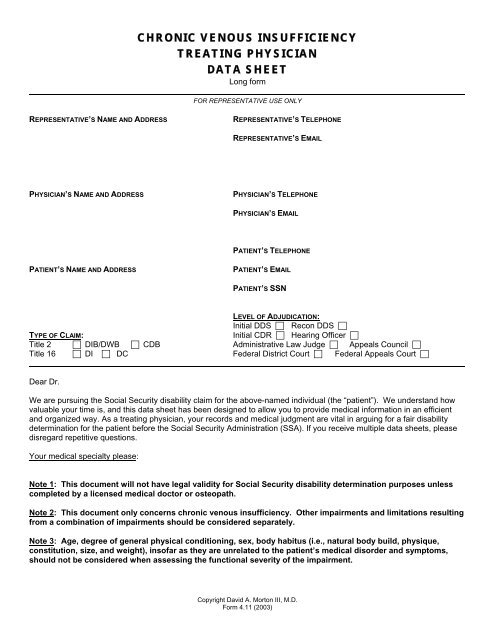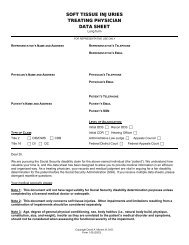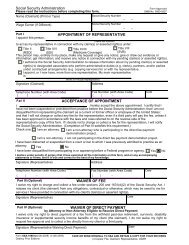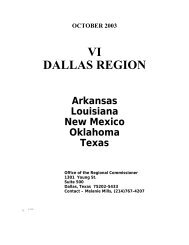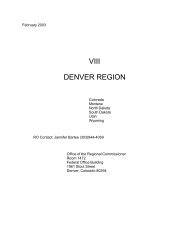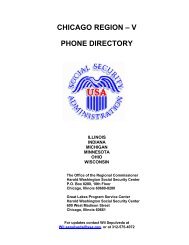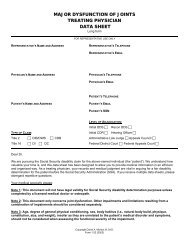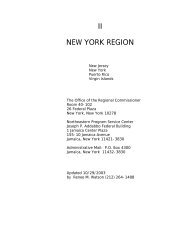Medical opinion form for chronic venous insufficiency
Medical opinion form for chronic venous insufficiency
Medical opinion form for chronic venous insufficiency
Create successful ePaper yourself
Turn your PDF publications into a flip-book with our unique Google optimized e-Paper software.
CHRONIC VENOUS INSUFFICIENCY<br />
TREATING PHYSICIAN<br />
DATA SHEET<br />
Long <strong><strong>for</strong>m</strong><br />
FOR REPRESENTATIVE USE ONLY<br />
REPRESENTATIVE’S NAME AND ADDRESS<br />
REPRESENTATIVE’S TELEPHONE<br />
REPRESENTATIVE’S EMAIL<br />
PHYSICIAN’S NAME AND ADDRESS<br />
PHYSICIAN’S TELEPHONE<br />
PHYSICIAN’S EMAIL<br />
PATIENT’S TELEPHONE<br />
PATIENT’S NAME AND ADDRESS<br />
PATIENT’S EMAIL<br />
PATIENT’S SSN<br />
LEVEL OF ADJUDICATION:<br />
Initial DDS Recon DDS <br />
TYPE OF CLAIM:<br />
Initial CDR Hearing Officer <br />
Title 2 DIB/DWB CDB Administrative Law Judge Appeals Council <br />
Title 16 DI DC Federal District Court Federal Appeals Court <br />
Dear Dr.<br />
We are pursuing the Social Security disability claim <strong>for</strong> the above-named individual (the “patient”). We understand how<br />
valuable your time is, and this data sheet has been designed to allow you to provide medical in<strong><strong>for</strong>m</strong>ation in an efficient<br />
and organized way. As a treating physician, your records and medical judgment are vital in arguing <strong>for</strong> a fair disability<br />
determination <strong>for</strong> the patient be<strong>for</strong>e the Social Security Administration (SSA). If you receive multiple data sheets, please<br />
disregard repetitive questions.<br />
Your medical specialty please:<br />
Note 1: This document will not have legal validity <strong>for</strong> Social Security disability determination purposes unless<br />
completed by a licensed medical doctor or osteopath.<br />
Note 2: This document only concerns <strong>chronic</strong> <strong>venous</strong> <strong>insufficiency</strong>. Other impairments and limitations resulting<br />
from a combination of impairments should be considered separately.<br />
Note 3: Age, degree of general physical conditioning, sex, body habitus (i.e., natural body build, physique,<br />
constitution, size, and weight), insofar as they are unrelated to the patient’s medical disorder and symptoms,<br />
should not be considered when assessing the functional severity of the impairment.<br />
Copyright David A. Morton III, M.D.<br />
Form 4.11 (2003)
I. Has the patient had any of the following impairments?<br />
Heart failure (Complete Form 4.02.)<br />
Hypertension (Complete Form 4.03.)<br />
Peripheral arterial disease (Complete Form 4.12.)<br />
II. Does the patient have <strong>chronic</strong> <strong>venous</strong> <strong>insufficiency</strong> of a lower extremity?<br />
If Yes, please answer the following questions.<br />
III. Does the patient currently have brawny edema?<br />
Left leg Yes No Unknown<br />
Right leg Yes No Unknown<br />
If Yes, how long has the edema been continuously present, by your examinations?<br />
Yes No Unknown<br />
If Yes, please give a detailed description of the extent of brawny edema, and rate severity on a scale of 1 – 4.<br />
(Photographs are very helpful, if available.)<br />
IV. Are any of the following abnormalities currently present? (provide photo if available, and provide a detailed<br />
description)<br />
A. Left leg.<br />
Superficial varicosities (include location and veins involved, and time present despite treatment)<br />
Stasis dermatitis (include area of leg involved, and time present despite treatment)<br />
Ulceration (include location and size, and time present despite treatment)<br />
Copyright David A. Morton III, M.D.<br />
Form 4.11 (2003)<br />
Page 2 of 8
B. Right leg.<br />
Superficial varicosities (include location and veins involved, and time present despite treatment)<br />
Stasis dermatitis (include area of leg involved, and time present despite treatment)<br />
Ulceration (include location and size, and time present despite treatment)<br />
V. Has the patient had <strong>venous</strong> imaging (e.g., x-ray contrast venography, MRI venography?)<br />
If Yes, please attach results and discuss important relevant findings.<br />
Yes No Unknown<br />
VI. Has the patient had any other <strong>venous</strong> studies per<strong><strong>for</strong>m</strong>ed, such as <strong>venous</strong> ultrasound?<br />
If Yes, please attach results and discuss important relevant findings.<br />
Yes No Unknown<br />
VII. Response to Treatment.<br />
Please specify the last date you examined the patient. Date: ___________<br />
A. <strong>Medical</strong> therapy<br />
1. Specify current medications and doses of drugs, or other medical treatment.<br />
Copyright David A. Morton III, M.D.<br />
Form 4.11 (2003)<br />
Page 3 of 8
2. Has the patient complained of drug-related symptoms? Yes No<br />
If Yes, what were the side-effects and treatment response?<br />
taking.<br />
3. Please list all non-prescription drugs, herbs, or other “alternative medicine” treatments the patient may be<br />
B. Surgical therapy<br />
Has the patient had surgery <strong>for</strong> <strong>venous</strong> disease? Yes No Unknown<br />
If Yes, specify date and nature of surgery and attach operative report if available.<br />
Did surgery relieve or improve the patient’s function or symptoms? Yes No Unknown<br />
Comments:<br />
C. Treatment compliance?<br />
Is the patient compliant with treatment? Yes No Unknown<br />
Comments:<br />
D. Current Clinical Condition.<br />
(Please include or attach physical examination, and other clinical vascular in<strong><strong>for</strong>m</strong>ation not previously discussed. )<br />
Copyright David A. Morton III, M.D.<br />
Form 4.11 (2003)<br />
Page 4 of 8
VIII. Current Functional Limitations and Capacities.<br />
Note: The following questions apply only to patients at least 18 years of age.<br />
In respect to the patient’s <strong>venous</strong> disease, please give your <strong>opinion</strong> in response to the following questions:<br />
A. Is the patient able to stand and/or walk 6 – 8 hours daily on a long term basis without worsening of <strong>chronic</strong> <strong>venous</strong><br />
<strong>insufficiency</strong>?<br />
Yes No Unknown<br />
If No, how long can the patient stand and/or walk (with normal breaks) in a 6 – 8 hour work day without<br />
worsening of <strong>venous</strong> <strong>insufficiency</strong> (and assuming compliance with treatment such as support stockings)?<br />
B. What maximum weight can the patient lift and/or carry occasionally (cumulatively not continuously)?<br />
Less than 10 lbs.<br />
10 lbs.<br />
20 lbs.<br />
50 lbs.<br />
100 lbs.<br />
Other (lbs.)<br />
Unknown<br />
C. What weight can the patient lift and/or carry frequently (cumulatively not continuously)?<br />
Less than 10 lbs.<br />
10 lbs.<br />
20 lbs.<br />
50 lbs. or more<br />
Other (lbs.)<br />
D. Work environment temperature restrictions.<br />
Unknown<br />
1. Aside from exertional considerations such as lifting and carrying, does the patient have restrictions against<br />
exposure to extreme heat or cold?<br />
If Yes, please define:<br />
Extreme heat (F°):<br />
Extreme cold (F°):<br />
Yes No Unknown<br />
Check the appropriate boxes:<br />
“Concentrated exposure” means 1/3 to 2/3 of 8 hour workday.<br />
“Moderate exposure” means very little up to 1/3 of 8 hour workday.<br />
Unlimited<br />
Avoid<br />
Concentrated<br />
Exposure<br />
Avoid Even<br />
Moderate<br />
Exposure<br />
Avoid All<br />
Exposure<br />
Extreme cold<br />
Extreme heat<br />
Copyright David A. Morton III, M.D.<br />
Form 4.11 (2003)<br />
Page 5 of 8
2. Would the patient’s exertional capacities <strong>for</strong> lifting and carrying (as described in B and C above) be further<br />
reduced by work in extremely hot or cold environments?<br />
Yes No Unknown<br />
If Yes, please use the following scale to indicate lifting and carrying capacity in relation to work environment<br />
temperature on blank chart following the example.<br />
EXAMPLE ONLY<br />
Environmental Work<br />
Temperature<br />
(Degrees Fahrenheit)<br />
Patient Can Lift<br />
(Pounds)<br />
O/F<br />
100 and over N<br />
95 – 100 N<br />
90 – 95 N<br />
85 – 90 10/5<br />
80 – 85 20/10<br />
75 – 80 20/10<br />
70 – 75 50/25<br />
65 – 70 50/25<br />
60 – 65 20/10<br />
55 – 60 20/10<br />
50 – 55 20/10<br />
45 – 50 10/5<br />
40 – 45 10/5<br />
35 – 40 N<br />
30 – 35 N<br />
25 – 30 N<br />
20 – 25 N<br />
15 – 20 N<br />
10 – 15 N<br />
5 – 10 N<br />
0 and below N<br />
N = no exposure<br />
O = weight to be occasionally lifted<br />
F = weight to be frequently lifted<br />
E. Specific types of exertion.<br />
FOR PHYSICIAN TO COMPLETE<br />
Environmental Work<br />
Temperature<br />
(Degrees Fahrenheit)<br />
100 and over<br />
95 – 100<br />
90 – 95<br />
85 – 90<br />
80 – 85<br />
75 – 80<br />
70 – 75<br />
65 – 70<br />
60 – 65<br />
55 – 60<br />
50 – 55<br />
45 – 50<br />
40 – 45<br />
35 – 40<br />
30 – 35<br />
25 – 30<br />
20 – 25<br />
15 – 20<br />
10 – 15<br />
5 – 10<br />
0 and below<br />
N = no exposure<br />
O = weight to be occasionally lifted<br />
F = weight to be frequently lifted<br />
Patient Can Lift<br />
(Pounds)<br />
O/F<br />
1. Can the following activities be per<strong><strong>for</strong>m</strong>ed (from a <strong>venous</strong> disease standpoint) while not lifting or carrying the<br />
amount of weight specified previously <strong>for</strong> given temperature conditions, or not applying equivalent <strong>for</strong>ce?<br />
Leg controls: never occasionally frequently<br />
Climbing: never occasionally frequently<br />
Squatting: never occasionally frequently<br />
Unknown<br />
2. Can the following activities be per<strong><strong>for</strong>m</strong>ed (from a <strong>venous</strong> disease standpoint) while lifting or carrying the<br />
amount of weight specified previously <strong>for</strong> given temperature conditions, or while applying equivalent <strong>for</strong>ce?<br />
Leg controls: never occasionally frequently<br />
Climbing: never occasionally frequently<br />
Squatting: never occasionally frequently<br />
Unknown<br />
Copyright David A. Morton III, M.D.<br />
Form 4.11 (2003)<br />
Page 6 of 8
IX. Additional Physician Comments. (Also list other disorders of which you are aware.)<br />
Physician’s Name (print or type)<br />
Physician’s Signature (no name stamps)<br />
Date<br />
Copyright David A. Morton III, M.D.<br />
Form 4.11 (2003)<br />
Page 7 of 8
X. Representative Notes.<br />
Copyright David A. Morton III, M.D.<br />
Form 4.11 (2003)<br />
Page 8 of 8


